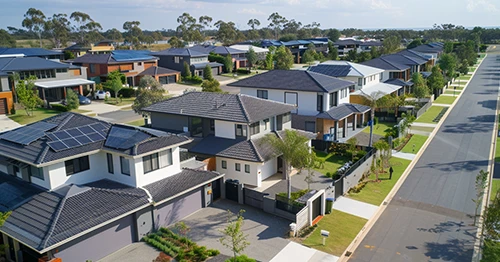Updated: 23 Dec, 2024
In October, CoreLogic’s Home Value Index (HVI) showed a modest rise of 0.3%, marking the 21st consecutive month of growth. The Australian property market showed further signs of cooling in October, with growth mainly driven by mid-sized capitals, while larger cities like Sydney and Melbourne softened. Though the market has generally grown since early 2023, the pace is easing, particularly in higher-priced urban areas. Perth led gains this month, while Darwin, Canberra, Melbourne, and Sydney recorded slight declines. The national trend reflects a gradually slowing market as affordability pressures and increased property listings shape buyer activity.
Here’s CoreLogic’s report in full.
State Performance Overview
The following table highlights each capital city’s housing market performance for October 2024.
| State | October Home Value Change | Description |
|---|---|---|
| Sydney | -0.1% | First monthly decline since January 2023, with upper quartile house values down 0.6% for the month. |
| Melbourne | -0.2% | Values declined 0.2%, following an ongoing trend of weakness across higher-priced properties. |
| Brisbane | +0.7% | Notable 0.7% rise, though growth has slowed to the lowest monthly gain since July. |
| Adelaide | +1.1% | A 1.1% increase marks the lowest rise since June, signalling cooling conditions. |
| Perth | +1.4% | Leading the capitals with a 1.4% increase, yet this is below earlier highs of 2% monthly growth. |
| Hobart | +0.8% | A slight gain amidst softer growth patterns in both home and rental markets. |
| Darwin | -1.0% | Market weakness persists with a 1.0% drop, showing volatile conditions. |
| Canberra | -0.3% | A 0.3% decline, aligning with the national trend of market cooldown. |
Regional Markets Vs. Capital Cities
In October, both capital city and regional housing markets showed moderate growth, with national dwelling values rising by 0.3% for the month and 0.9% for the quarter. Combined capital cities recorded a quarterly increase of 0.8%, while regional markets slightly outpaced them with a 1.1% rise. Over the past year, capital cities achieved a 5.9% growth rate, with regional areas at 6.3%, highlighting stronger resilience in regional markets.
Perth led the capital cities with an impressive 4.1% quarterly increase and a substantial 22.6% annual growth rate. Among regional areas, overall growth trends also remained positive, with national median dwelling values reaching $809,849, signalling consistent demand across the country, despite signs of a broader market slowdown.
Rental Market Overview
National rents showed a slight increase of 0.2% in October, lower than typical October growth in recent years, bringing annual growth down to 5.8%, the slowest pace since early 2021. This cooling is easing inflation pressures, with the rental component of CPI falling to 6.7% in the September quarter.
Rental conditions have softened more in the unit sector, with cities Sydney, Melbourne, Brisbane, Hobart and Canberra experiencing declines. House rents also dipped slightly in some areas, influenced by lower net migration and a shift to larger household sizes post-pandemic.
Gross rental yields in capital cities edged down to 3.47% in October, though investor demand remains strong, with investment lending higher over the past year despite rising holding costs.
Market Forecast
- Affordability Remains A Barrier: Affordability will continue to challenge buyers, especially if housing prices remain elevated.
- Potential Rate Cuts In Q1 2025: A possible rate cut could lift buyer sentiment, although careful monitoring of household debt levels is likely.
- Increased Property Listings: A rise in listings, especially in Sydney and Melbourne, is expected to provide more options for buyers and extend selling times.
- Stabilising Rental Market: The rental market may show slower growth as affordability concerns and lower migration levels reshape demand.
- Ongoing Supply Shortages: Persistent construction delays and the tight labour market are likely to limit new housing supply, helping sustain prices.




